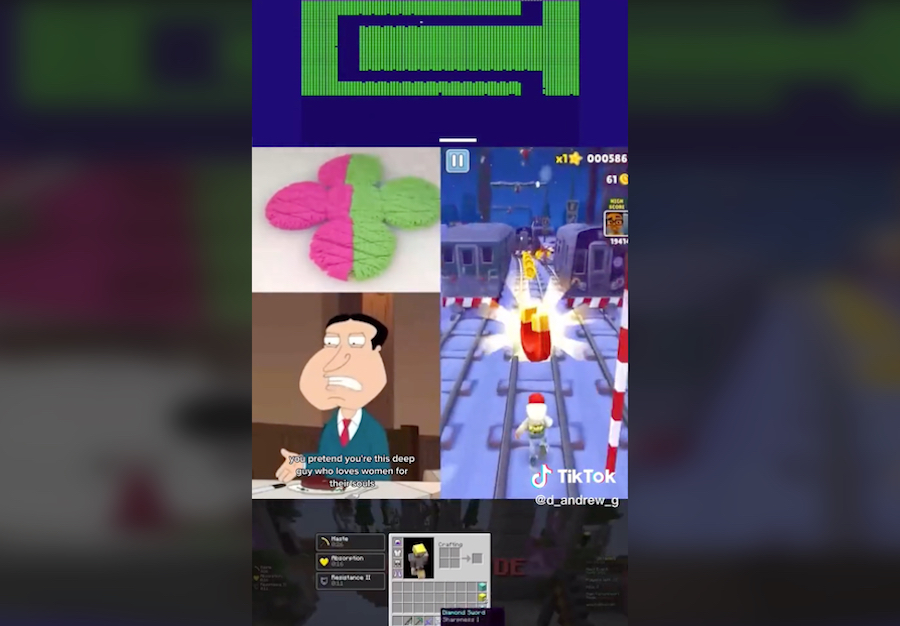TikTok "Sludge Content" and Tips For Better Focus!

We all know that person who can watch television while still getting all their homework done. Or someone who listens to music performing every task maybe ever. We live in a time with the possibility of endless stimulation, and TikTok is part of that wheel of distractions that splits our focus, whether we think we can multitask or not.
Yet, even within TikTok, focus has become split through the introduction of what is called "sludge content". These are two videos spliced into one; while one video focuses on the actual content, like a clip from a show or movie, there is another video below or above containing unrelated materials. This material is usually a sensory video with ASMR elements, like someone cutting soap or playing with slime. The purpose of sludge content is to have viewers stay longer for the actual content. By offering two videos in one, creators give audiences more stimulation, and particularly for longer videos, many viewers leave quickly as attention wanes.
@d_andrew_g Family Guy Content #familyguy#familyguymemes#fyp#funny#content#sludge#shipost#quagmire#subwaysurfers#slime#satisfying#brickbreaker#minecraft#minecraftmemes♬ original sound - D_Andrew_G
As it grows in popularity, sludge content is worrying for what it may prove about our attention spans, which are already on the decline. So, here are a few science-backed tools for improving focus and attention!
MEDITATION
13 minutes is the recommended time for improving focus, though any amount of meditation can help, usually showing results around the 8-week mark. Meditation is best practiced in the morning, as it can increase energy -- which may not be wanted as the day winds down towards sleeping time. Focus meditation in particular involves clearing the mind to hone in on the sensation of breath and the body. It can be accomplished through a body scan leading from toes to head. In this body scan, you sense for places of discomfort and pain, notice the feelings of the body, and move on. This type of meditation is difficult at start; many of us have racing minds and thoughts that tend to interrupt the process. The key is to accept the thought and gently refocus. Meditation becomes easier with practice and offers a powerful tool for combatting the need for constant stimulation.
DELIBERATE COLD EXPOSURE
While many believe stress is antithetical to focus, raising cortisol levels can actually improve focus and attention. Via a cold shower or bath at an uncomfortably cold but not freezing temperature, you can raise your cortisol and dopamine levels together. Recommended exposure is 1 to 5 minutes, and the trick is to allow your body to, afterwards, do the work of warming itself up. Even though it feels not-so-great at first submersion, cold exposure is an unexpected but significant way to combat split attention.
TAKING A WALK
Exercise is beneficial for almost everything in the body, particularly as our lives become more sedentary. Taking a walk outdoors is, while simple, one of the best exercises for improving focus. By going on a walk, you have a sense of objects passing, an “optic flow” that helps clear the mind and focus in on surroundings. Walking is tied directly to thinking, and it also improves creativity. It’s not just a physical exercise but a mental one that can be deeply grounding.
SLEEP AND OTHER RESTING TOOLS
Sleeping is one of the most crucial activities for focus and attention. People are generally recommended to get 8-10 hours of sleep a night, but that doesn’t always happen in our busy lives. For better sleep, it is important to limit late caffeine and screen-time, keep a cooler temperature in the bedroom, and not eat too close to bedtime. Yet, if you’re someone who has difficulty with sleep, a great tool is yoga nidra, also known as NSDR (non-sleep deep rest). There are guided videos on YouTube, but the premise is essentially 30 to 60 minutes of laying down, shut-eyed time, even if you are not asleep. It helps with chronic sleep deprivation, and while sleep should still be prioritized, it is a tool for those who struggle with it.
CUTTING DOWN SCREENTIME
The dreaded and obvious solution to a lot of attention problems is lessening screen time. Cell phones are so stimulating, and the constant barrage of texts, emails, and notifications is both exhausting and harmful to health. A good start is to set a bedtime with your phone and have a wind-down activity before bed that does not involve a screen — something like coloring, reading, or even doing a craft like knitting. From there, you can further limit screen activities, but if it is difficult, smaller steps include setting times where your notifications do not come through or taking a social media break. Phones are a way to connect and entertain, but they are not the only ways to do these things.
Sludge content is worrisome. If viewers can’t focus on a 3-minute video without other stimulation, it is a sign that our attention is in a state of crisis. These tips may not solve the full range of concerns regarding attention, but they’re a start for anyone wanting to improve concentration and their ability to perform activities.
Let us know if any of these tips work for you. If we can focus in on focusing, maybe we won’t need sludge content anymore!



